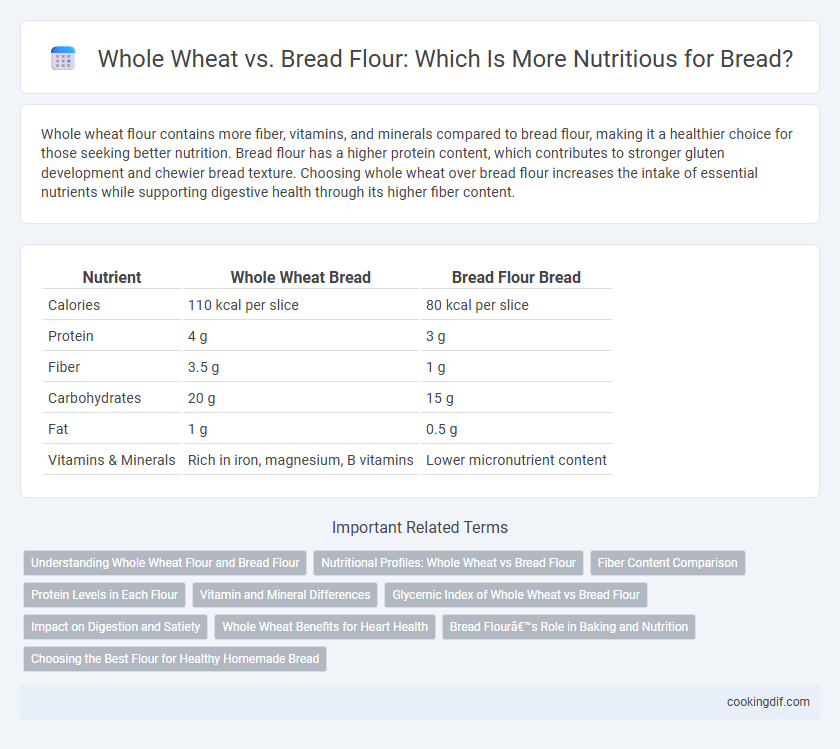Whole wheat flour contains more fiber, vitamins, and minerals compared to bread flour, making it a healthier choice for those seeking better nutrition. Bread flour has a higher protein content, which contributes to stronger gluten development and chewier bread texture. Choosing whole wheat over bread flour increases the intake of essential nutrients while supporting digestive health through its higher fiber content.
Table of Comparison
| Nutrient | Whole Wheat Bread | Bread Flour Bread |
|---|---|---|
| Calories | 110 kcal per slice | 80 kcal per slice |
| Protein | 4 g | 3 g |
| Fiber | 3.5 g | 1 g |
| Carbohydrates | 20 g | 15 g |
| Fat | 1 g | 0.5 g |
| Vitamins & Minerals | Rich in iron, magnesium, B vitamins | Lower micronutrient content |
Understanding Whole Wheat Flour and Bread Flour
Whole wheat flour contains the entire grain kernel, including bran, germ, and endosperm, resulting in higher fiber, vitamins, and minerals compared to bread flour. Bread flour is milled primarily from hard wheat and has a higher protein content, typically 12-14%, which provides stronger gluten development for better bread structure. Nutritionally, whole wheat flour offers more complex carbohydrates and antioxidants, while bread flour focuses on superior baking qualities rather than enhanced nutrient density.
Nutritional Profiles: Whole Wheat vs Bread Flour
Whole wheat flour retains the bran and germ, providing higher fiber content, essential vitamins like B-complex, and minerals such as iron and magnesium, which contribute to better digestion and heart health. Bread flour, primarily made from refined wheat with higher protein levels (typically 12-14%), offers superior gluten strength that improves bread texture but lacks the rich nutritional profile found in whole wheat. Choosing whole wheat flour supports increased dietary fiber intake and a more balanced nutrient profile, while bread flour is favored for baking quality and gluten development.
Fiber Content Comparison
Whole wheat flour contains significantly higher fiber content than bread flour, providing about 12-15 grams of dietary fiber per 100 grams compared to bread flour's 2-3 grams. The fiber in whole wheat aids digestion and helps regulate blood sugar levels, making it a healthier option for those seeking to boost fiber intake. Choosing whole wheat bread promotes better heart health and supports weight management through its increased fiber density.
Protein Levels in Each Flour
Whole wheat flour contains about 13-14% protein, providing a higher fiber content and more nutrients due to the inclusion of bran and germ. Bread flour generally has a protein content of 12-14%, optimized for gluten development, promoting better dough elasticity and rise. Choosing whole wheat flour enhances nutritional intake with additional vitamins and minerals, while bread flour mainly supports texture and structure in baking.
Vitamin and Mineral Differences
Whole wheat flour contains higher levels of vitamins and minerals compared to bread flour, including significant amounts of B vitamins such as thiamine, riboflavin, and niacin, which support energy metabolism. It also provides essential minerals like iron, magnesium, and zinc due to the retention of the bran and germ. Bread flour, typically refined and lower in fiber, offers fewer micronutrients but is favored for its higher gluten content, impacting bread texture rather than nutritional value.
Glycemic Index of Whole Wheat vs Bread Flour
Whole wheat flour typically has a lower glycemic index (GI) compared to bread flour, which helps in better blood sugar management and sustained energy release. The higher fiber content in whole wheat slows carbohydrate absorption, reducing rapid spikes in blood glucose levels. Bread flour, often more refined, lacks this fiber, resulting in a higher GI and quicker digestion.
Impact on Digestion and Satiety
Whole wheat flour contains higher fiber content than bread flour, significantly enhancing digestion by promoting regular bowel movements and supporting gut health. The increased fiber in whole wheat also contributes to greater satiety, helping to control appetite and reduce overall calorie intake. In contrast, bread flour, with lower fiber levels, digests more quickly and may lead to shorter-lasting fullness.
Whole Wheat Benefits for Heart Health
Whole wheat flour retains the bran and germ, making it rich in fiber, vitamins, and antioxidants that support cardiovascular health. The high fiber content in whole wheat helps lower LDL cholesterol and stabilize blood sugar levels, reducing the risk of heart disease. In contrast, bread flour, typically refined, lacks these heart-protective nutrients, making whole wheat a superior choice for heart health.
Bread Flour’s Role in Baking and Nutrition
Bread flour, with its higher protein content of 12-14%, provides better gluten development, resulting in chewier, more elastic bread texture compared to whole wheat flour. While whole wheat flour offers increased fiber and micronutrients from the bran and germ, bread flour's refined nature allows for superior rise and volume in baking. Nutritionally, bread flour is lower in fiber but contributes essential amino acids critical for protein synthesis in the body.
Choosing the Best Flour for Healthy Homemade Bread
Whole wheat flour retains the bran, germ, and endosperm, providing higher fiber, vitamins, and minerals compared to bread flour, which is refined and primarily contains endosperm with more gluten for better elasticity. Choosing whole wheat flour enhances nutrient intake and supports digestive health, while bread flour creates lighter, softer textures ideal for specific bread types. For healthy homemade bread, blending whole wheat and bread flour balances nutrition and texture, maximizing both flavor and health benefits.
Whole Wheat vs Bread Flour for nutrition Infographic

 cookingdif.com
cookingdif.com